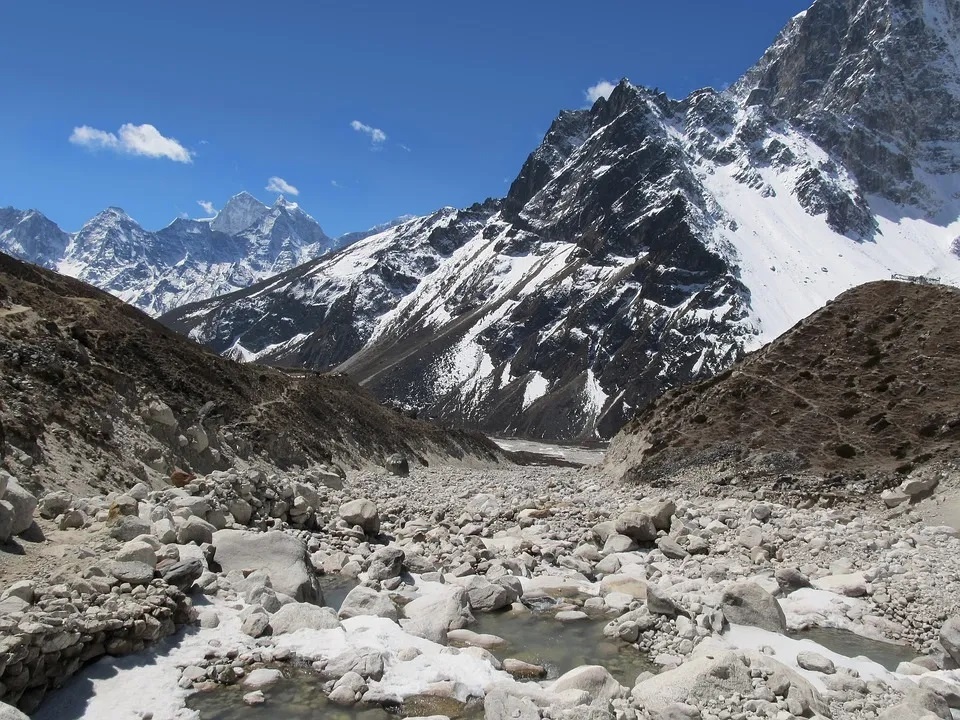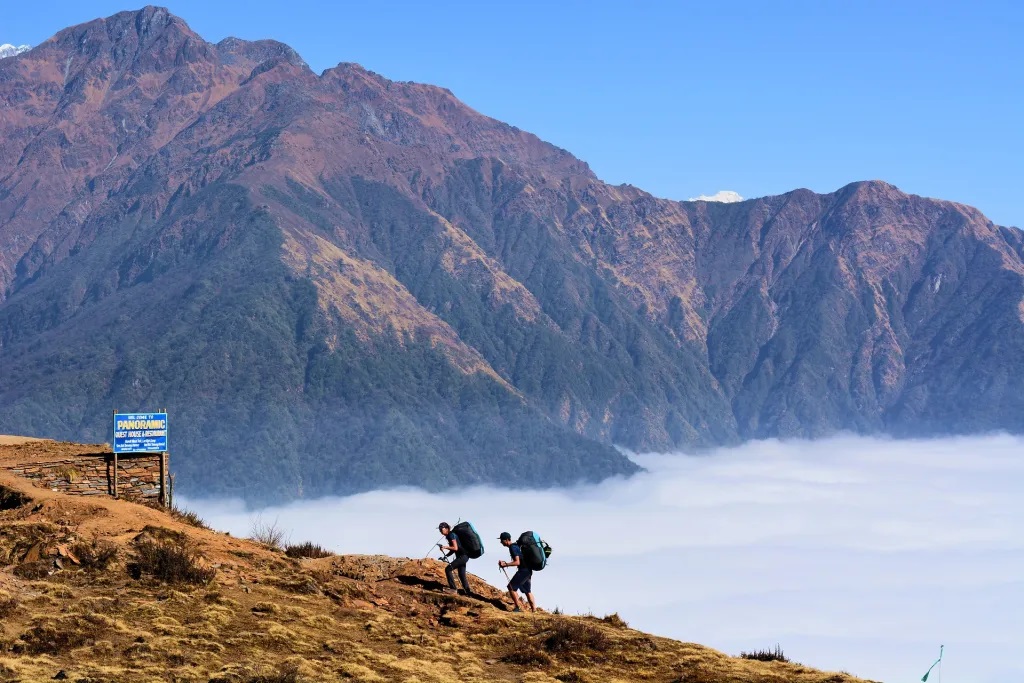There are literally hundreds of treks available for trekking in Nepal with new routes opening up each year to cater for the growing interest in trekking in more remote areas. All of these treks follow the main routes & then branch off into different valleys before returning to the objective of the main area like reaching a view of the summit of Mount Everest. And these main routes are amply supplied with a great number of guest houses & lodges along the routes which will provide you with a warm bed, good fresh food & a conversation at the end of the day. But if you are looking for more adventure then you need to look towards some of the more remote trekking routes (here please talk to us if you wish this because we can then point you to the trekking companies who specialise in those areas).
Though most trekkers know their limits as well as time available & will choose a trek from the main routes like the following three, Annapurna, Everest & Langtang. Each area offers a variety of routes of various distances & challenges which can suit almost everyone. So those are the three main routes we have listed on our website (please scroll down from this page for more details) & here is a brief look at each area.
Langtang
The Langtang region is easily accessible from Kathmandu valley and makes it perfect for travellers with a limited time in Nepal. Because between five to ten days, one can visit Langtang area for trekking and experience the Himalayan region even though they are not quite as spectacular as in the Annapurna or Everest areas, they remain unforgettably beautiful. And because of this you will find the trails are less crowded and the people are friendlier because the less tourists the more they are appreciated. The area itself was first established as national park for Himalayan wildlife & because of this is criss-crossed with hiking and trekking paths and mountaineering trails allowing visitor’s unparalleled accessibility. From trails like these you often see musk deer (Moschus chrysogaster) and Himalayan Tahr (Hemitragus jemlahicus), Himalayan black beer (selenarctos thibetanus), snow leopard (panthera uncia), wild god (cuon alpinus), ghoral (Nemorhedus goral) serow (capricornis sumantrenis) and more than 250 species of birds.But the park is also renowned for its population of red panda (Ailurus fulgens).

A little further up the valley is Kyanjin Gompa, where you can stop overnight and sample the local yak cheese. And then farther up the trail you will pass through Nubamatang which is nestled in a hidden valley on the way up to view the glacier which is the gateway into Tibet. Before finally backtracking to travel through Syabru and Sing Gompa to a high plateau, where the sacred lake Gosaikunda is located. Crossing the Lauribna Pass (4610m) to continue south, leaving the Langtang region behind as you travel through the Helambu valley to Gul Bhanjyang. From here it’s just a few days trek back to Kathmandu.
So if you are looking for a taster to trekking in Nepal or only have enough time for a short hike into the Himalayas this region is ideal for you.
Annapurna range

The Annapurna region is located in the heart of Nepal Himalayas and dominated by the majestic mountains that make up the Annapurna range. Using Pokhara as a base you can access three major trekking routes in central Annapurna Region i.e. Jomsom-Muktinath, Annapurna Sanctuary and Annapurna circuit (Thorong la Pass 5416 m) itself. Starting at Beshisahar (843 m) at the foot of the mountains and is known as the gateway of Annapurna circuit trekking likewise Pokhara is also a main gateway to explore various short treks of one to four – five days, including the Royal trekking, Siklesh trekking, short Ghorepani – Poonhill trekking. And with people with a little longer time can cover the Annapurna Sanctuary, Annapurna Base Camp, Khayar Trek, Mardi Himal Trek, Panchase Trekking and Jomsom – Muktinath trekking in one to 2 weeks.
Approximately two-thirds of the visitors of Nepal visit the Annapurna region for trekking because of its easy access, nice hotels in the hills and good scenery of both high mountains and lowland villages.
But please note Mustang is also geographically a part of the Annapurna region, but because treks to Mustang are subject to special restrictions, this is described it in the separate page because they are also less popular.
Annapurna Conservation Area Project (ACAP)
The ACAP project was established in 1986 under the guidance of the King Mahendra Trust for Nature Conservation and encompasses the entire Annapurna range, more than 7600 sq. km. Back then it was an innovative approach to environmental protection as it was declared a “conservation area” instead of a national park. But because of the large number of people who lived within this region the involvement of local people was sought with an emphasized environmental education.
Part of the project included the training of lodge owners, with an emphasis on sanitation, deforestation and cultural pride who in turn passed on the knowledge to the operators to encourage hoteliers to charge a fair price for food and accommodation. On top of this ACAP encouraged the use of kerosene for cooking throughout the region, and requires its use above Chhomrong in the Annapurna Sanctuary and on the route between Ghandruk and Ghorepani. And to maintain this decree that a “conservation fee” of Rs 2000 would be collected from all trekkers who obtain trekking permits for the Annapurna region. And used this money to improve the sanitation system by encouraging the construction of toilets throughout the area; use them no matter how disgusting they are. ACAP has also made provision for the supply of kerosene in those parts of the conservation area where using firewood is totally prohibited. In addition to providing information, they established a centre that sells iodine, solar battery chargers and other products that can help you to protect the environment while you are trekking in Nepal Annapurna range
Everest region
The Mt.Everest region has gained its popularity for trekking in Nepal experience , peak climbing and expedition and has become a major destination for thousands of trekkers each year. And this has been helped by the building of the airport at Lukla because before then it took at least a week to walk from Jiri just to enter the national park. Add the fact that Mount Everest became worldwide news when it was conquered by Sir Edmund Hilary & Sherpa Tensing has only added to the increasing numbers who wish to hike in these mountains. It’s located in the northeast of Nepal a 10-day walk through the middle hills of Solu to the higher altitudes of Khumbu to the base of Sagarmatha, or Mt. Everest, the world’s highest peak, is an opportunity to observe and participate in the daily life of the legendary Sherpa people.

The primary goal of trekking in Everest region is stopping at least the Everest Base Camp (5360m.) but try to hike to the Kalapathar (5545m) as well as it offers amazing and stunning views of hundreds of mountains as well as glacier in 360 deg angle.
Mountain peaks like Mt. Lhotse, Mt. Nuptse, Mt. Amadablem, Mt. Pumori, Mt. Thamserku, Mt.Kantega, Kwangde and others can be seen. The region itself offers varieties of trekking trails and some of them are given below as given sample trek packages. Along the trail, the travellers would experience the typical Sherpa culture in the alpine settlements such as Lukla, Phakding, Monjo, Namche Bazaar, Khhumjung, Thame, Tyangboche, etc. But Note hiking at this high altitude has a high risk of Acute Mountain Sickness (AMS) if due emphasis is not given for acclimatization. If symptoms like headache, loss appetite and vomiting are seen you should immediately inform to the guide so that he would facilitate to take first aid treatment or take you to the nearby health post. However, if the situation is critical or serious case he will coordinate with the office for the rescue arrangements.
